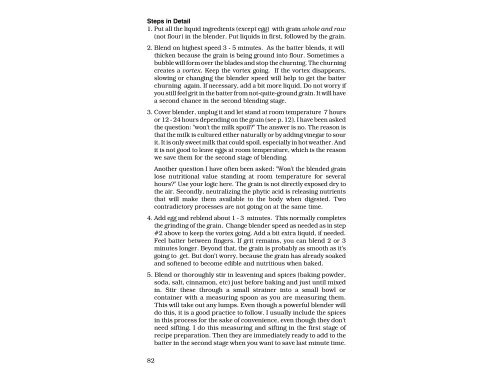Whole Grain Baking - Sue Gregg Cookbooks
Whole Grain Baking - Sue Gregg Cookbooks
Whole Grain Baking - Sue Gregg Cookbooks
Create successful ePaper yourself
Turn your PDF publications into a flip-book with our unique Google optimized e-Paper software.
Steps in Detail<br />
1. Put all the liquid ingredients (except egg) with grain whole and raw<br />
(not flour) in the blender. Put liquids in first, followed by the grain.<br />
2. Blend on highest speed 3 - 5 minutes. As the batter blends, it will<br />
thicken because the grain is being ground into flour. Sometimes a<br />
bubble will form over the blades and stop the churning. The churning<br />
creates a vortex. Keep the vortex going. If the vortex disappears,<br />
slowing or changing the blender speed will help to get the batter<br />
churning again. If necessary, add a bit more liquid. Do not worry if<br />
you still feel grit in the batter from not-quite-ground grain. It will have<br />
a second chance in the second blending stage.<br />
3. Cover blender, unplug it and let stand at room temperature 7 hours<br />
or 12 - 24 hours depending on the grain (see p. 12). I have been asked<br />
the question: "won't the milk spoil?" The answer is no. The reason is<br />
that the milk is cultured either naturally or by adding vinegar to sour<br />
it. It is only sweet milk that could spoil, especially in hot weather. And<br />
it is not good to leave eggs at room temperature, which is the reason<br />
we save them for the second stage of blending.<br />
Another question I have often been asked: "Won't the blended grain<br />
lose nutritional value standing at room temperature for several<br />
hours?" Use your logic here. The grain is not directly exposed dry to<br />
the air. Secondly, neutralizing the phytic acid is releasing nutrients<br />
that will make them available to the body when digested. Two<br />
contradictory processes are not going on at the same time.<br />
4. Add egg and reblend about 1 - 3 minutes. This normally completes<br />
the grinding of the grain. Change blender speed as needed as in step<br />
#2 above to keep the vortex going. Add a bit extra liquid, if needed.<br />
Feel batter between fingers. If grit remains, you can blend 2 or 3<br />
minutes longer. Beyond that, the grain is probably as smooth as it's<br />
going to get. But don't worry, because the grain has already soaked<br />
and softened to become edible and nutritious when baked.<br />
5. Blend or thoroughly stir in leavening and spices (baking powder,<br />
soda, salt, cinnamon, etc) just before baking and just until mixed<br />
in. Stir these through a small strainer into a small bowl or<br />
container with a measuring spoon as you are measuring them.<br />
This will take out any lumps. Even though a powerful blender will<br />
do this, it is a good practice to follow. I usually include the spices<br />
in this process for the sake of convenience, even though they don't<br />
need sifting. I do this measuring and sifting in the first stage of<br />
recipe preparation. Then they are immediately ready to add to the<br />
batter in the second stage when you want to save last minute time.<br />
82


